The Kid with a Bike, directed by Jean-Pierre and Luc Dardenne
 The Kid With a Bike
The Kid With a BikeThe latest film by the Dardenne brothers, like their previous work, (La Promesse, Rosetta, Le Fils (The Son) and L’Enfant (The Child)), is set in the largely French-speaking southern half of Belgium, and specifically in the Seraing municipality, where the two filmmakers grew up.
The WSWS has written at length on the work of these filmmakers (see “The Dardenne brothers: But what about the ‘extenuating circumstances’?” 29 September 2008, and “The Dardenne brothers’ L’Enfant: An argument for a far more critical appraisal,” 30 June 2006), and it must be said that their latest work does not break much new ground. It shares the strengths as well as the weaknesses of their earlier films, and the weaknesses are serious.
Their work treats problems of modern life with realism and sincerity, in contrast to so much of what is produced and distributed today. Its working class characters are portrayed with some honesty and sympathy, but they also remain largely undeveloped, and the personal crises they face are consciously divorced from the world in which they live. The desolation of deindustrialized Belgium remains little more than a backdrop to stories of suffering, personal struggles and a redemption that arises mysteriously, out of something that looks very much like a religious impulse.
 The Kid With a Bike
The Kid With a BikeThe Kid With a Bike tells the story of Cyril Catoul (Thomas Douret), who appears to be about 11 years old and has been placed in a youth farm. His father Guy (Jeremie Renier), has dropped his son off and apparently promised to return for him later. It turns out that Guy has quickly moved out of his flat and disappeared from Cyril’s life.
Under these undeniably wrenching conditions, the young boy is a cauldron of emotions that he cannot possibly express in words. He is by turns angry, defiant, silent and sullen. He constantly attempts to run off to find his father, whom he insists has not deserted him. The young actor who portrays Cyril is extremely effective in depicting the feeling of abandonment and rejection, of having no one in the world to turn to.
Cyril has convinced himself that there has been some mixup, and that his father is waiting to take him back. The film uses a whirl of activity from Cyril to set a tone of heedless determination on his part to put his family back together and to flee what he clearly considers a form of imprisonment.
He is also determined to retrieve his bike—his passionate attachment to it is what gives the movie its title. The bike and the father together represent what little security Cyril has in life, what little makes his life worth living. When he is informed that his father sold the bike, he refuses to believe it, insisting that the bike was stolen. Later discovering that the bike was sold after all, his anger and defiance grows.
The heart of the story is Cyril’s relationship with Samantha (Cecile De France), who runs a beauty salon in the area and whom he meets in a medical office that he enters as he attempts to flee the youth home. Seeking to resist workers trying to bring him back to the home, he grabs onto the nearest person, who happens to be Samantha, and holds on for dear life. Samantha does not recoil. She later agrees to take him in for weekends.
A number of developments follow, all related to the challenges that Samantha and Cyril face—Cyril in finding some stability in his life, and Samantha in winning his trust and apparently in finding some meaning in her life as well, although this theme is never developed.
One of the subplots involves the successful effort of a petty thief in the area to make Cyril his lackey in one of his schemes. The young boy, now facing the fact that he has no father in his life and desperately looking for a substitute, focuses all of his attention on this local gangster who is barely out of his own teenage years. This leads in turn to new disasters and challenges, with Samantha fighting to save her young charge from a doomed future.
The Dardennes use cinematic and storytelling techniques that are familiar from their earlier films. The focus remains on the problems of youth and young adults. The whirlwind of activity is another characteristic of some of their work, communicating something of the energy and profusion of sensory perceptions that are part of young people’s lives.
The acting in The Kid With a Bike is uniformly good, and it gives the 87-minute film some effective moments. There is an unusual use of music, often absent from the Dardennes’ earlier films. A very short excerpt from the slow movement of Beethoven’s Fifth Piano Concerto, little more than a snippet, is reprised on three or four occasions. At first it seems effective as a kind of punctuation of different scenes. One is reminded, however, of the terse dialogue in this and other films by the Dardenne brothers. Terseness is not necessarily artistic truth, not by itself.
Specifically, in this movie, the interpersonal exchanges are kept as brief as possible, and sometimes it seems as though frenetic activity, alternating with silence or a few brief words, is a substitute for dialogue and dealing more deeply with issues that lurk in the background.
The actors are not given enough material by the Dardennes, who have written the screenplay in addition to directing the film. We barely get to know Cyril’s father, although he plays a pivotal role in this story. Cyril’s attachment to him drives the narrative, at least to begin with, but there is no effort to explain the attachment, and nothing beyond two or three sentences to show why he has abandoned his son. Such actions are not unheard of, but they also demand further exploration.
Samantha is similarly undeveloped. Cyril’s sullen silence and anger is understandable, but what about the woman who takes him in? At one point she is forced to choose between the young boy and a man in her life, but the consequences and implications of the choice are never probed. Instead, she is presented almost as a religious symbol of goodness.
What is consistently missing from the Dardennes’ films are the social conditions without which their characters and their stories cannot fully come to life. The subjects of these movies are similar to those in the films of Ken Loach and Mike Leigh, but it must also be said that these latter directors are more forthright and in the final analysis more interesting and revealing because they deal with the social questions that the Dardennes avoid.
